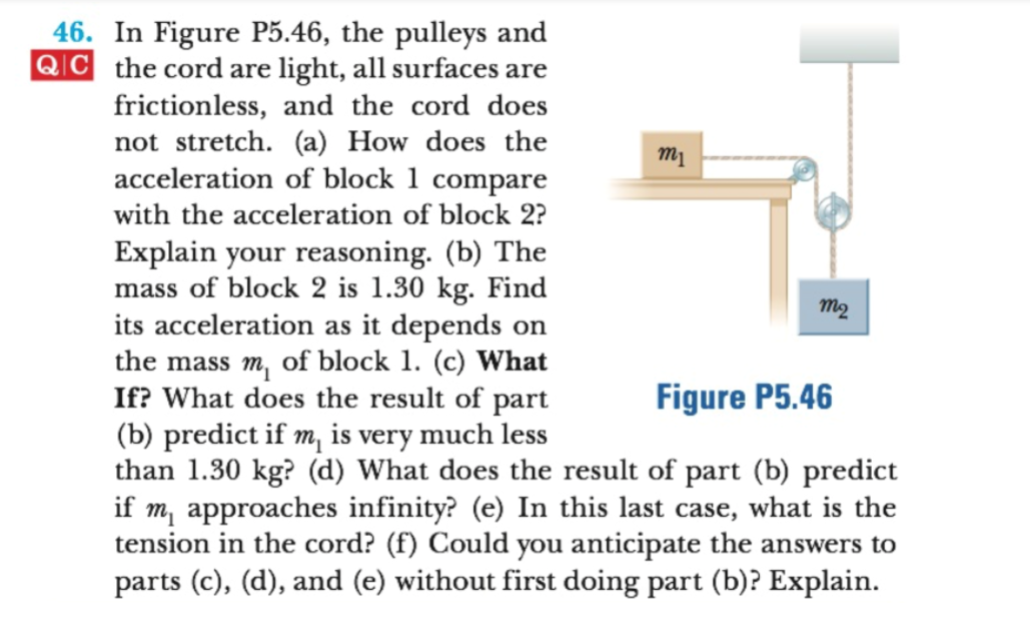46. In Figure P5.46, the pulleys and Q C the cord are light, all surfaces are frictionless, and the cord does not stretch. (a) How does the acceleration of block 1 compare m1 with the acceleration of block 2? Explain your reasoning. (b) The mass of block 2 is 1.30 kg. Find its acceleration as it depends on the mass m, of block 1. (c) What If? What does the result of part (b) predict if m is very much less than 1.30 kg? (d) What does the result of part (b) predict if m approaches infinity? (e) In this last case, what is the tension in the cord? (f) Could you anticipate the answers to parts (c), (d), and (e) without first doing part (b)? Explain m2 Figure P5.46
46. In Figure P5.46, the pulleys and Q C the cord are light, all surfaces are frictionless, and the cord does not stretch. (a) How does the acceleration of block 1 compare m1 with the acceleration of block 2? Explain your reasoning. (b) The mass of block 2 is 1.30 kg. Find its acceleration as it depends on the mass m, of block 1. (c) What If? What does the result of part (b) predict if m is very much less than 1.30 kg? (d) What does the result of part (b) predict if m approaches infinity? (e) In this last case, what is the tension in the cord? (f) Could you anticipate the answers to parts (c), (d), and (e) without first doing part (b)? Explain m2 Figure P5.46
University Physics Volume 1
18th Edition
ISBN:9781938168277
Author:William Moebs, Samuel J. Ling, Jeff Sanny
Publisher:William Moebs, Samuel J. Ling, Jeff Sanny
Chapter6: Applications Of Newton's Laws
Section: Chapter Questions
Problem 49P: (a) If half of the weight of a small 1.00103-kgutility truck is supported by its two drive wheels, s...
Related questions
Question

Transcribed Image Text:46. In Figure P5.46, the pulleys and
Q C the cord are light, all surfaces are
frictionless, and the cord does
not stretch. (a) How does the
acceleration of block 1 compare
m1
with the acceleration of block 2?
Explain your reasoning. (b) The
mass of block 2 is 1.30 kg. Find
its acceleration as it depends on
the mass m, of block 1. (c) What
If? What does the result of part
(b) predict if m is very much less
than 1.30 kg? (d) What does the result of part (b) predict
if m approaches infinity? (e) In this last case, what is the
tension in the cord? (f) Could you anticipate the answers to
parts (c), (d), and (e) without first doing part (b)? Explain
m2
Figure P5.46
Expert Solution
This question has been solved!
Explore an expertly crafted, step-by-step solution for a thorough understanding of key concepts.
This is a popular solution!
Trending now
This is a popular solution!
Step by step
Solved in 6 steps with 4 images

Recommended textbooks for you

University Physics Volume 1
Physics
ISBN:
9781938168277
Author:
William Moebs, Samuel J. Ling, Jeff Sanny
Publisher:
OpenStax - Rice University

College Physics
Physics
ISBN:
9781938168000
Author:
Paul Peter Urone, Roger Hinrichs
Publisher:
OpenStax College

Principles of Physics: A Calculus-Based Text
Physics
ISBN:
9781133104261
Author:
Raymond A. Serway, John W. Jewett
Publisher:
Cengage Learning

University Physics Volume 1
Physics
ISBN:
9781938168277
Author:
William Moebs, Samuel J. Ling, Jeff Sanny
Publisher:
OpenStax - Rice University

College Physics
Physics
ISBN:
9781938168000
Author:
Paul Peter Urone, Roger Hinrichs
Publisher:
OpenStax College

Principles of Physics: A Calculus-Based Text
Physics
ISBN:
9781133104261
Author:
Raymond A. Serway, John W. Jewett
Publisher:
Cengage Learning

College Physics
Physics
ISBN:
9781285737027
Author:
Raymond A. Serway, Chris Vuille
Publisher:
Cengage Learning

Physics for Scientists and Engineers
Physics
ISBN:
9781337553278
Author:
Raymond A. Serway, John W. Jewett
Publisher:
Cengage Learning

Physics for Scientists and Engineers with Modern …
Physics
ISBN:
9781337553292
Author:
Raymond A. Serway, John W. Jewett
Publisher:
Cengage Learning